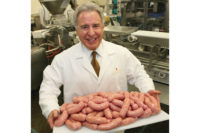On a roll
TX-based Owens Country Sausage is more than a regional product arketer, and its administrators say they can prove it — pinpointing such trides as a growing new-product portfolio, new executive leadership, and a brand new processing plant.
By Barbara Young, Editor-In-Chief
Surviving in business for more than seven decades is not a happenstance achievement, no matter how well the pieces may fall together. Just ask those associated with TX-based Owens Inc., a sausage-making company born in a farmhouse kitchen and now 75 years later, ranks among the leading U.S. regional sausage manufacturers generating sales in the tens-of-million-dollar range.
“We concentrate on quality, taste, and integrity — the fundamentals of our company — whether concerning our traditional sausage or our newer convenience products designed to complement the lifestyles of today’s busy consumers,” notes Mike Townsley, president, appointed last year to replace retiring president and chief operating officer Vinson Kirchner.
Reviewing Townsley’s credentials, Stewart Owens, the third-generation leader of his family’s sausage business until Bob Evans Farms acquired it in 1987, spotlights his experience, and management style.
“It seems to be a great fit for our business,” notes Owens, now chairman and chief executive officer of Bob Evans Farms. “His previous responsibilities in developing and implementing sales and marketing plans and in managing a large sales force are valuable assets.”
Over time, Townsley held positions with the industry’s elite pork and beef processing firms, most recently at Kansas City-based Premium Standard Farms.
“I’m looking at building on the strong performance tradition and sound heritage of quality products,” says Townsley, adding that he intends the business to grow on guidance and counseling under his watch.
“My background is in sales,” he emphasizes. “I have a great appreciation for the sales side of business. I don’t profess to know how to run a machine, but my experience has prepared me to know the right questions to ask. I don’t expect my associates to necessarily see my vision because we must come to the final picture together.”
To be sure, sausage commands the starring role in that final picture, the making of which Townsley acknowledges involves a cast with challenges.
“We are positioned to grow our business knowing that our biggest competition is not merely other sausage companies,” Townsley affirms. “Our challenge is to make products to tailor modern consumers’ desires.”
But what about strategies? “We plan to continue developing relationships with key customers,” Townsley answers. “Today the main driver is our brand, but we’re very interested in private-label business. In fact, we already have some relationships in the works.”
Without question, product-development distinction is an effective marketing tool, but that alone does not guarantee business advancement, as savvy business operators know. The right business connections can make all the difference, however, as is the case concerning Owens.
While functioning as an independent operating company, Owens is backed by the muscle, reputation, and financial strength of its parent Bob Evans Farms Inc., a billion-dollar public company with holdings on the sausage manufacture side and restaurant ownership in the foodservice arena — including several TX-based Owens® Family Restaurants.
“We have the best of two worlds between both companies,” Townsley says. “Owens is not a small company that is an easy target for consolidation. Thanks to the combined size and scale of our organization, we are well-positioned to compete on a nationwide basis. Furthermore, we have the strength and fortitude to do business over the long haul, unlike others our size that may face being absorbed by a bigger company.”
Owens, headquartered in the Dallas suburb of Richardson since 1928, markets a diversified array of branded products including fresh sausage roll, links, and patties. Fresh sausage rolls rank number-one in sales followed by Snackwiches, the Owens’ pioneering line of convenience sandwiches featuring biscuits filled with sausage, egg, and cheese. The line also includes sausage cheeseburgers with a mini-burger bun. Products targeting various times of the day include Owens’ signature “Border Breakfast” microwaveable selections of soft flour tortillas filled with sausage meat, aged cheddar cheese, eggs, and garden fresh vegetables. Owens also markets mashed potatoes, hams, chili, and smoked sausage.
Based on recent independent research data, sales of Owens patties grew by 58 percent last year, followed by links at 20 percent.
Townsley attributes the success of patties to the company reputation of producing quality sausage rolls.
The company recently began offering 8-ounce cartons of fully cooked Owens Express sausage links in original and maple flavors, with a suggested retail price of $2.49 for 10 links. Initial plans call for testing the product in Texas, Oklahoma, and Denver before broadening the distribution territory.
“We’re moving away from poly bags to only cartons as our packaging of choice,” notes Terry Russell, vice president of sales and 30-year Owens veteran. “We call this our next generation packaging concept.”
Recalling the early days of total direct-store-deliveries, Russell says delivering to customers’ warehouses has streamlined the company’s distribution system.
“We were going too far between stops due to the long travel distances in Texas,” he explains. “We have converted much of our distribution to warehouses.”
To be sure, products define marketing initiatives undertaken by the team responsible for Owens’ business development strategies. Moves, such as leadership changes, capital investment programs, and new construction projects also provide measurements of growth.
To that end, Owens marked its 75th anniversary last year in September with the purchase of property in Sulphur Springs, half way between Dallas and Texarkana heading northeast on Highway 30. The plant ships product throughout the United States to Southwestern states, the Midwest, mid-Atlantic locations, and Southeastern regions.
A new division is born
Among the valid reasons to put as much distance as possible between processing facilities handling raw product and those dedicated to cooking product, nothing is more compelling than food-safety issues.
| Building a legacy: Sausage company saga By Barbara Young Editor-In-Chief
|
|
The imprints of C.B. (Clifford Boyce) Owens and his wife Kate — who together planted a seed in 1928 that 75 years later has sprouted into a major contender within the realm of sausage-making — remain as an indelible reminder of a dream realized. The journey began when the couple leased a 100-acre farm in Richardson, TX, and began making “country-style” sausage for a handful of customers on a neighbor’s weekly “butter and egg route.” The business continues its pattern of growth in the facility the couple built in 1963, replacing their production plant in downtown Richardson, where their cottage industry first made its mark as a commercial enterprise beginning in 1947 — the year they captured their first wholesale outlet customer: the 17-location Dallas Food stores. Current customers represent top retail and wholesale accounts across the Southwest including Wal-Mart, HEB, Kroger, Albertsons, Brookshire Foods, United Supermarket, Grocer’s Supply, and Affiliated Foods. The complex on East Lookout Drive retains its country farm persona in a community dominated by urban corporate architecture and four-lane highways. To be sure, the rolling green grounds of Owens Spring Creek Farm — the original family homestead and now home to company-owned miniature ponies and Belgians grazing in the grass side by side near a quiet pond— is a Norman-Rockwell-kind-of-setting. Other attractions include a museum depicting scenes of typical lifestyles in the 1920s, illustrated with a butcher shop, country store, country kitchen, and a farmer’s workshop. Antique wagons and other Owens memorabilia decorate a nearby barn. How Owens Country Sausage — born in the state of Texas covering more than 268,000 square miles within its borders – grew from a side business on the farm into a modern corporation unfolds in timely milestones. By 1955, Owens operated with a sales branch in Tyler, TX, followed later by more branches in Houston and San Antonio. Product went to market in 12 delivery trucks. Owens grew into an interstate business with its first customers in Shreveport, LA, in 1963. A self-promotion campaign using a Belgian horse team to pull a company wagon in parades and other special events began that same year. Jerry Owens, who learned the business under the tutelage of his parents beginning at age 5, succeeded his father as president in 1973. Jerry Owens’ son Stewart, following his father’s route in business, became vice president in 1980 and the third-generation head of the business four years later as president and chief operating officer. Ushering the family business to a new level, Stewart Owens negotiated its sale to Columbus, OH-based Bob Evans Farms in a stock transaction worth nearly $16 million, but retained his leadership position at Owens. Recruited to join the parent company in an administrative capacity in 1990, Stewart Owens quickly moved from group vice president of food products to chairman of the board and chief executive officer at Bob Evans Farms.
|
Moreover, as Townsley reports, the single plant reached capacity two years before the company broke ground for the new facility.
“We knew we needed to expand,” he says. “There was considerable pressure on the workforce in Richardson.”
When the opportunity came allowing the company to acquire a second plant to ease overcapacity pressures at its original and only production facility in Richardson, creating a food-safety marvel was primary.
The ideal facility came in an existing four-year-old building on several acres of land in the northwest area of Sulphur Springs, more than an hour’s drive from company headquarters 70 miles away.
“Besides sanitation issues, the biggest opportunity related to improving traffic flow to control bacteria and for ample storage capacity,” explains Phil Chapman, vice president of production. “We also upgraded freezer and refrigeration capacity.”
As the quality assurance manager, Karrie Menz, an 11-year Owens veteran, knows that plant-floor drains are major conduits for bacteria, especially Listeria monotocytogenes with its wet-environment proclivity.
“Our new plant layout empowered us to control our program,” Menz says. “We incorporated stainless drains designed for easy and complete cleaning. Drains are scrubbed deep inside nightly followed by rinsing and sanitizing — with acids, caustics, and iodine. Powdered iodine is administered as an extra kill step during the day.”
A “hands-off” approach girds the overall handling policy at the plant housing automatic doors without pull-cord openers. Boots receive special sanitation attention.
“We operate with a captive boot policy,” Menz confirms.
Last year in June, a new $4-million 52,777-square-foot sandwich production complex capable of an 18-million pound output annually emerged, and 89 associates, representing the initial staffing of the 120 expected ultimately, began the online process.
With 85 feet of unused space on the production side, the plant is capable of future expansion up to three additional lines, Chapman reports.
“As we convert our sandwich assembly operation, we also are transitioning to other initiatives at the new plant, including formulation upgrades and packaging concepts,” he says. “We eliminated the existence of cardboard on the plant floor.”
Sandwich makings include biscuits, sausage patties, IQF (individually quick frozen) pasteurized egg patties, and cheese rounds sliced from a log onsite.
A newly formulated biscuit sporting enhanced butter-flake flavor and improvements in texture and color represents one upgrade. Moreover, Owens is phasing out polygon-shaped biscuits in favor of a round configuration.
Meanwhile, just 30 days into production in mid-January, the two-shift operation assembled as many as 200 packaged sandwiches a minute on one of two lines operating in the plant.
“One line is more automated than the other,” notes Chapman, emphasizing that the operation “is still in the midst of startup, but I know the difference between good and bad.”
The original plant is by no means a relic
Times were certainly different when C.B. Owens moved his family sausage production operation to a brand new bigger and more modern facility of 100,000 square feet in 1963. For one thing, the Owens clan gained strength using brawn and human stamina before such innovations as manufacturing plants, delivery trucks, and refrigeration systems.
If walls could talk, those in the 41-year-old facility, where a changing workforce produced mostly sausage over four decades, much of how the Owens business evolved would come forth.
In any case, C.B. Owens would recognize the facility he built by its façade — the interior is another matter, however. For the most part, machines now perform jobs previously handled by people, and plant supervisors bring college degrees to their positions.
Courtney Anderson, plant supervisor for nearly two years, began her career in Richardson as a recent graduate of Texas A&M University.
Automation is the cornerstone of the Richardson plant, dedicated to production of Owens’ “Border Breakfast” line on a single shift under the supervision of Anderson, among others. Equipment includes spiral freezers and automatic box assembly systems. The production team is capable of assembling 216 individual tortilla rolls a minute.
Townsley and his associates are not unmindful of pressures on food producers brought on by global obesity issues. “The Atkins diet is boosting our business,” he says. “In fact we are gearing up to be able to add a nutritional claim to our ingredient legend.”
Meanwhile, the Owens sausage business no doubt will keep on rolling.



Report Abusive Comment